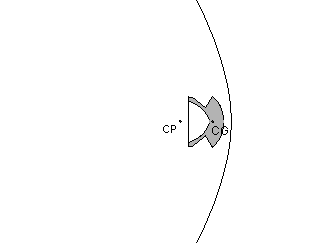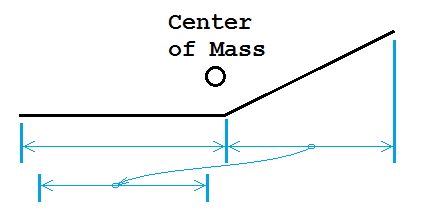It seems the stable orientation of the cone shaped space capsule while free falling through the atmosphere is having the bottom point towards the translational velocity relative to the atmosphere. Can someone explain the aerodynamics of this (stabilization) mechanism?
-
$\begingroup$ Because it's bottom-heavy? But that's also true of a cone of uniform density. My guess is that the primary concern is thermal, not aerodynamic, per se. $\endgroup$– PM 2RingCommented Jan 7, 2019 at 9:42
-
$\begingroup$ The cone upside down fall is not stable, that is why. $\endgroup$– Vladimir KalitvianskiCommented Jan 7, 2019 at 9:46
-
$\begingroup$ @VladimirKalitvianski: If the right side up orientation is also unstable, object will just chaotically tumble. Why does it seem to regress to this orientation? Most importantly, the question asks for the aerodynamics of any of the orientation, stable or unstable. $\endgroup$– HansCommented Jan 7, 2019 at 9:57
-
$\begingroup$ @PM2Ring: There is no active rocket firing to control the orientation. $\endgroup$– HansCommented Jan 7, 2019 at 9:58
-
$\begingroup$ Because if it is not well oriented, there is a net torque from the narrow part of the cone. As the bottom is heavier (I guess), its attraction to the Earth is higher than that of the narrow part, but the hydraulic resistance is proportional to the size or the size squared, not as the force (size in the third), so there is inequality of forces and torques that orients the cone bottom downwards. $\endgroup$– Vladimir KalitvianskiCommented Jan 7, 2019 at 10:16
4 Answers
We assume the following.
1) The force exerted by the air on a surface is pure pressure thus normal to the surface without friction. The pressure is an increasing function of the magnitude of the incoming air flow velocity component that is normal to the impinging surface.
2) The surface of the capsule is axially symmetric. Label the intersection of the symmetric axis and the surface (bottom) facing the incoming airflow $B$. The inward normal vector $\vec n$ of any infinitesimal surface patch either intersects the axis at point $N$ some finite distance from $B$ or $\vec n$ parallels the axis. The center of mass of the capsule $C$ locates between $B$ and $N$.
The capsule will achieve aerodynamic stability.
Before presenting the proof of this proposition, I give plausible toy model of this air flow pressure function. The realistic function will surely be more complicated.
However, interestingly, two and a half months after I posted this answer, I happened upon the theory of hypersonic aerodynamics that surprisingly endorsed almost fully the following derivation as the correct computation for the pressure of hypersonic (Mach 3-5) airflow on an largely axial symmetric body with blunt surface geometry. c.f. equations (11-2) and (11-3) of chapter 11 on the hypersonic aerodynamics of W. H. Mason's lecture on configuration aerodynamics. Search for "Newtonian Impact Theory" in this accompanying PPT to that chapter.
Suppose an air column of an infinitesimal cross section area $dA$ collide with a facet with its normal vector forming an angle $\theta\in\big[0,\frac\pi2\big]$ with the air flow direction vector. The air bounces off the facet completely elastically. The momentum change (all in the normal direction of the facet) per unit time is then $2\rho v^2\cos\theta dA$, where $\rho$ is the density of the air flow and $v$ the speed of it. The area upon which this momentum change occurs is $\frac{dA}{\cos\theta}$. Divide the first quantity by the second, we get the pressure $p(\theta):=2\rho v^2\cos^2\theta$. Now the early arriving particles bounce off of the surface normally and collide completely elastically with the late arriving particles and bounce back towards the surface again. By symmetry, the average particle velocity near the surface vanishes in the surface normal direction but its component tangent to the surface remains. Macroscopically, the fluid on average as a whole moves along the tangent of the surface.
Moreover, the part of the object surface that is in the "shadow" of the incoming airflow will remain untouched by the airflow and thus experience no pressure.
Proof:
1) 2-dimension.
Let us formulate the problem formally. Let $s\in[-s_0,s_0],\,s_0>0$ measure the distance, with sign, from the intersection of the symmetry axis with the surface. Denote the unit inward normal vector at $s$ by $\hat n(s)$. Let $\theta(s)$ be the angle from $\hat n(0)$ to $\hat n(s)$ with counterclockwise direction as the positive direction for the angle. $\theta(-s)=-\theta(s)$ by the axial symmetry. Let the angle from $\hat n(s=0)$ to the incoming airflow direction be $\theta_a$ also with counterclockwise direction as the positive direction. Place the curve $(x(s),y(s))$ in the Cartesian coordinate such that $(x(s=0)=0,y(s=0)=0)$ and the center of mass be located at $(x=0,y=y_c)$. We have $(x(-s),y(-s))=(-x(s),y(s))$. Let $p(\beta)$ be the pressure as a function of the angle $\beta$ with respect to the incoming air flow. The torque at each curve with respect to $(0,y_c)$ is $l(s)p(\theta_a-\theta(s))$ where $l(s)\hat z = \big((x(s),y(s))-(0,y_c)\big)\times \hat n(s)$.
Without loss of generality we assume $\theta_a>0$. Otherwise we can just reflect the coordinate with respect to the $y$ axis and get back the same problem because of the axial symmetry.
The total torque is, needing only to account for the surface facing the incoming airflow, \begin{align} T&:=\int_{-s_0}^{s_0}l(s)p(\theta_a-\theta(s))ds \\ &=\int_0^{s_0}l(s)\big(p(\theta_a-\theta(s))-p(\theta_a+\theta(s))\big)\,ds \end{align} as $l(-s)=-l(s)$ by the axial symmetry of the curve. Stability is achieved if $T>0$. We have $l(s)>0,\,\forall s>0$ since, by Assumption 2), the center of mass $C$ located at $(0,y_c)$ is between $N$ (at the origin of the coordinate $(0,0)$) and $B$. $p(\theta_a-\theta(s))>p(\theta_a+\theta(s))$, since $|\theta_a-\theta(s)|<\theta_a+\theta(s),\ \forall \theta_a>0,\, \theta(s)>0,\, s>0$, and the fact that $p(u)>p(v),\,\forall |u|<|v|$. Therefore $T>0$.
2) 3-dimension
The 3-dimensional case can be reduced to the 2-dimensional one above by symmetry.
(to be continued)
QED
If I wasn't terrible at drawing, I would make an illustration. But think of an egg falling through air. The bottom as quite flat. If it falls bottom first and starts to rotate a bit to any side, the air pressure will increase on this side and bring it back to the bottom first position, so this position is stabilized.
Now think of the egg falling again, but this time with the tip first. As soon as it starts rotating, the air pressure will increase on the tilted side and increases the rotation. This position is unstable.
-
1$\begingroup$ This is not a satisfactory answer. I understand the air pressure has to be such as to stabilize the orientation. This explanation sounds like justifying the result after knowing it. My question is how, geometrically, it is exactly doing so and to predict the stable orientation without knowing it in advance. $\endgroup$– HansCommented Jan 7, 2019 at 11:23
This answer is posted in Space Exploration https://space.stackexchange.com/questions/61398/during-spacecraft-reentry-why-is-heatshield-side-down-the-most-stable-orientatio/61404#61404. Don't know the Stack Exchange etiquette for copy/pasting answers, but here it is
We’re accustomed to seeing things travelling pointy-end forwards (bullets, rockets, arrows, Lamborghinis) so it seems “natural” that Entry Vehicles (EV) should be most stable traveling pointy-end first as well. Not so.
For example, bullets are inherently unstable since their Center of Gravity (CG) is behind their Center of Pressure (CP). They only achieve relative static stability due their extremely high spin rate, hundreds of thousands of RPMs.
An airgun pellet (they sometimes travel supersonic) has static stability since the CG is ahead of the CP
A sphere has static stability due to its symmetry
A portion of a sphere has a similar shock wave to a complete sphere. As long as the CG is ahead of the center of spherical curvature, the object is statically stable.
The static stability of a spherical section is assured if the vehicle's center of mass is upstream from the center of curvature
https://en.wikipedia.org/wiki/Atmospheric_entry#Entry_vehicle_shapes
A EV has a similar shape to the pizza pie section above, but rounded at both ends. The relationship between its CG and CP is similar to an airgun pellet.
If this EV is travelling pointy end first, the curvature generating the shock wave has a much shorter radius. This places the CG behind the CP and creates static instability, just like a bullet.
-
$\begingroup$ As a rule of thumb, if a complete answer elsewhere is useful, it’s better to link than to duplicate. If a naked link feels inadequate, a link with a brief summary is better than a wholesale duplication. No worries in this case, but guidance for the future. $\endgroup$– rob ♦Commented Jan 1, 2023 at 18:22
Here's my guess:
Since the heat shield is not planar, when it pitches off-center one side of the heat shield presents more area to the flow, providing a corrective torque. It depends on the center of mass being close enough to the base of the heat shield.
-
$\begingroup$ That is exactly why I find it puzzling and what you have said wrong, because the projective area left of the center of mass is smaller than the right, and thus the net torque should rotate the cone counterclockwise, rather exacerbates the error than corrects it. $\endgroup$– HansCommented Jan 8, 2019 at 15:14
-
$\begingroup$ @Hans: The airflow is coming up vertically from the bottom, so the radius seen on the left is larger, so the torque is clockwise. $\endgroup$ Commented Jan 9, 2019 at 1:27
-
$\begingroup$ I agree with your first statement. The rest is wrong. Where do you put the center of the torque to measure your radius, if not the center of the mass? If you agree, then the radius seen to the left of the center of mass is smaller. Your plot is wrong. The middle vertical bar should be drawn right underneath the center of mass and not the bending point as you have done. $\endgroup$– HansCommented Jan 9, 2019 at 2:18
-
$\begingroup$ @Hans: OK, lower the center of mass if you like. $\endgroup$ Commented Jan 9, 2019 at 17:13
-
$\begingroup$ The torque is always counter-clockwise so long as the center of mass is above the bottom and is only zero when the center of mass is exactly on the bottom which is impossible. Even in the latter case, it is only zero and will never stabilize the capsule. So your mechanism is obviously wrong. As I have said before, this was the very first thing came to my mind when I looked at the geometry and found it puzzling. There got to be more intricate dynamics here. $\endgroup$– HansCommented Jan 9, 2019 at 17:43






![]](https://i.sstatic.net/MR0IY.png)
